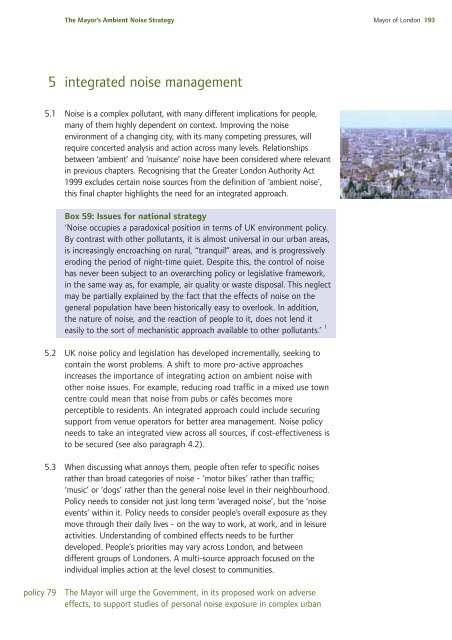The Mayor's Ambient Noise Strategy - Greater London Authority
The Mayor's Ambient Noise Strategy - Greater London Authority
The Mayor's Ambient Noise Strategy - Greater London Authority
Create successful ePaper yourself
Turn your PDF publications into a flip-book with our unique Google optimized e-Paper software.
<strong>The</strong> Mayor’s <strong>Ambient</strong> <strong>Noise</strong> <strong>Strategy</strong> Mayor of <strong>London</strong> 193<br />
5 integrated noise management<br />
5.1 <strong>Noise</strong> is a complex pollutant, with many different implications for people,<br />
many of them highly dependent on context. Improving the noise<br />
environment of a changing city, with its many competing pressures, will<br />
require concerted analysis and action across many levels. Relationships<br />
between ‘ambient’ and ‘nuisance’ noise have been considered where relevant<br />
in previous chapters. Recognising that the <strong>Greater</strong> <strong>London</strong> <strong>Authority</strong> Act<br />
1999 excludes certain noise sources from the definition of ‘ambient noise’,<br />
this final chapter highlights the need for an integrated approach.<br />
Box 59: Issues for national strategy<br />
‘<strong>Noise</strong> occupies a paradoxical position in terms of UK environment policy.<br />
By contrast with other pollutants, it is almost universal in our urban areas,<br />
is increasingly encroaching on rural, “tranquil” areas, and is progressively<br />
eroding the period of night-time quiet. Despite this, the control of noise<br />
has never been subject to an overarching policy or legislative framework,<br />
in the same way as, for example, air quality or waste disposal. This neglect<br />
may be partially explained by the fact that the effects of noise on the<br />
general population have been historically easy to overlook. In addition,<br />
the nature of noise, and the reaction of people to it, does not lend it<br />
easily to the sort of mechanistic approach available to other pollutants.’ 1<br />
5.2 UK noise policy and legislation has developed incrementally, seeking to<br />
contain the worst problems. A shift to more pro-active approaches<br />
increases the importance of integrating action on ambient noise with<br />
other noise issues. For example, reducing road traffic in a mixed use town<br />
centre could mean that noise from pubs or cafés becomes more<br />
perceptible to residents. An integrated approach could include securing<br />
support from venue operators for better area management. <strong>Noise</strong> policy<br />
needs to take an integrated view across all sources, if cost-effectiveness is<br />
to be secured (see also paragraph 4.2).<br />
5.3 When discussing what annoys them, people often refer to specific noises<br />
rather than broad categories of noise - ‘motor bikes’ rather than traffic;<br />
‘music’ or ‘dogs’ rather than the general noise level in their neighbourhood.<br />
Policy needs to consider not just long term ‘averaged noise’, but the ‘noise<br />
events’ within it. Policy needs to consider people’s overall exposure as they<br />
move through their daily lives - on the way to work, at work, and in leisure<br />
activities. Understanding of combined effects needs to be further<br />
developed. People’s priorities may vary across <strong>London</strong>, and between<br />
different groups of <strong>London</strong>ers. A multi-source approach focused on the<br />
individual implies action at the level closest to communities.<br />
policy 79<br />
<strong>The</strong> Mayor will urge the Government, in its proposed work on adverse<br />
effects, to support studies of personal noise exposure in complex urban
















